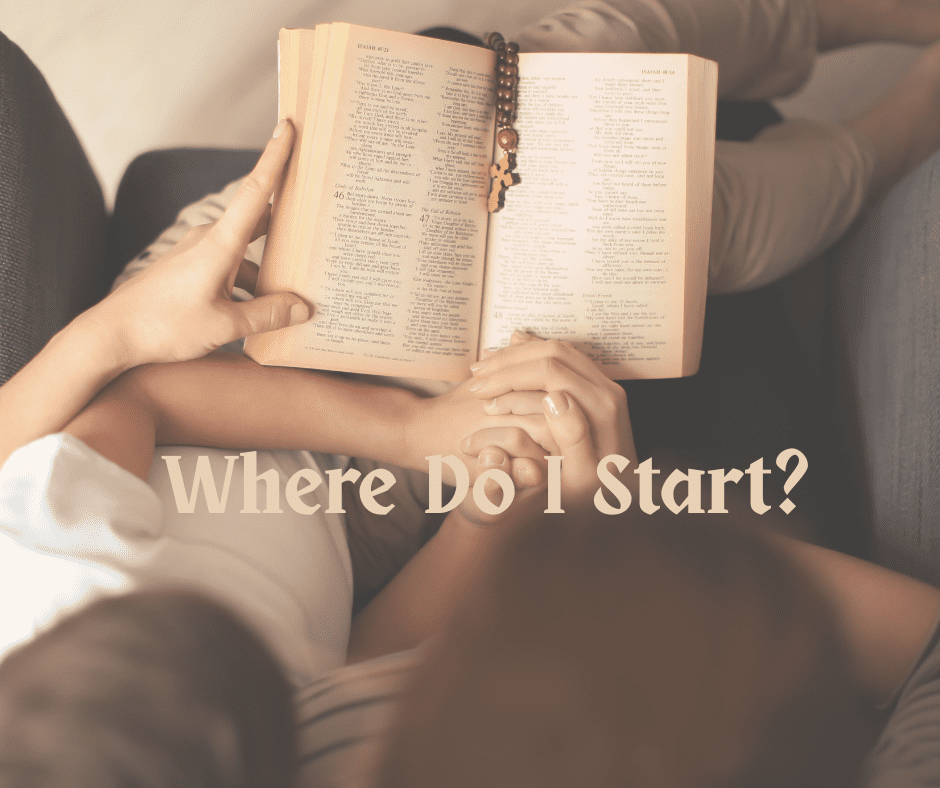Reading the Catholic Bible for the first time can feel overwhelming.
Where do you start? How do you make sense of it? And how do you keep going when you hit confusing parts like Leviticus or Revelation?
If you’ve ever felt this way, you’re not alone. The Catholic Bible isn’t just another book. It’s a living Word, meant to shape your soul, not just fill your mind.
So if you’re holding a Bible for the first time (or the first time in a long time), here’s a faithful, approachable way to begin, rooted in tradition, grounded in wisdom, and totally doable.
✝️ 1. Don’t Start at the Beginning (Really)
It may seem logical to begin in Genesis, but that’s like trying to understand a movie by watching the prequels first. You’ll miss the heart of the story.
Start with Jesus. The Gospels are the core of Scripture and the lens through which everything else makes sense.
🔹 Start with Luke (accessible and orderly)
🔹 Then read Acts of the Apostles (also by Luke)
🔹 Follow with Matthew, Mark, and John
This gives you a solid foundation in Christ’s life, ministry, and the early Church.
📖 2. Choose a Catholic Bible Translation
Not all Bibles are the same. Many popular versions omit key books (like Sirach and Maccabees) that are part of the Catholic canon.
Best Catholic translations:
- New American Bible Revised Edition (NABRE) – used at Mass in the U.S.
- Revised Standard Version – Catholic 2nd Edition (RSV-CE) – great for study
- Douay-Rheims – more traditional, poetic, and literal
Look for the Imprimatur—a mark of Church approval—on the inside cover.
🙏 3. Begin with Prayer
This isn’t just reading, it’s listening. Ask the Holy Spirit to guide you before you even begin.
Simple opening prayer:
“Speak, Lord, your servant is listening. Help me to understand and live what I read.”
You don’t need to “get it all” right away. The goal is relationship.
🗂️ 4. Follow a Simple 3-Step Reading Plan
Avoid random page-flipping. A reading plan gives you direction and motivation.
Step 1: Meet Jesus
- Luke
- Acts
- Psalms (one per day)
Step 2: Grow in Wisdom
- Proverbs
- Sirach
- James
Step 3: Understand Salvation History
- Genesis
- Exodus
- Romans
- Revelation (read last—it’s dense, but powerful)
📌 TIP: Read one chapter per day, or one Psalm and one Gospel story. Keep it simple and consistent.
🧠 5. Use a Study Bible or Catholic Companion Resource
You’re not expected to figure it all out alone. Scripture was meant to be read in the community of the Church.
Great tools:
- The Bible in a Year podcast (Fr. Mike Schmitz)
- Ignatius Catholic Study Bible (RSV-2nd Catholic Edition)
- Laudate or Hallow App (for daily readings and reflections)
These tools help you avoid misinterpretation and go deeper with historical and Church context.
🕊️ 6. Go to Mass—It Will All Start to Click
If you’re reading the Bible and attending Mass, you’ll start recognizing Scripture everywhere, in the readings, the prayers, and the liturgy itself.
The Mass is the Bible come to life.
Hearing the Word of God proclaimed in the context of worship helps Scripture move from head knowledge to heart transformation.
✍️ 7. Reflect and Write It Down
Keep a small notebook or journal. Each time you read, write:
- A verse that stood out
- A question you had
- A way it applies to your life
You’ll be amazed how God speaks through repetition, reflection, and time.
🚫 What Not to Do
- Don’t try to read too much at once
- Don’t feel bad if you don’t understand everything
- Don’t skip prayer
- Don’t treat it like a checklist—this is a conversation, not a chore
👶 Bringing the Faith to Life with Young Kids
You don’t need a theology degree to begin forming your children in the faith. In fact, the early Church grew in homes through stories, song, rhythm, and prayer.
Here are a few easy ways to begin:
- Start a daily prayer ritual—just one Our Father or Hail Mary together after breakfast or before bed.
- Read a simplified Bible storybook—The Catholic Children’s Bible or My First Catechism.
- Talk about the saints—introduce them as our “heavenly friends.” St. Augustine had a rough start. St. Monica was a praying mom. Kids get it. For my favorite book on saint’s click here (contains affiliate link that I make a small commission for at not charge to you)
- Go to Mass, even if it’s messy—they’re learning by being there, even if it feels chaotic.
- Let your kids see you reading Scripture—they notice. They imitate.
I know I’m not the only kid who played Mass with a few crackers and some grape juice. If you know, you know.
Early Church Fathers
If you aren’t ready to read the Bible just yet, you can always start here with this list of writings. The Early Church Fathers can be a powerful turning point. They reveal that the earliest Christians believed, worshiped, and taught in ways strikingly similar to the Catholic Church today. Click here for a reading list of the Early Church Fathers
Reading the Church Fathers is like discovering the missing link between Scripture and the Church today. For many, they’ve been the “aha moment” that bridges the gap between the Bible and the Catholic Mass, tradition, and authority.
Did you miss the pop-up? Click the link below to get your FREE Catholic Bible Guide.
Related Reading:
Check out:
–How Grace, Gratitude, and Faith Changed My Parenting
–The Rise of Homeschooling: Why Families Are Reclaiming Childhood, Faith, and Education
–Why Having Three Kids Is Easier Than One
For more faith-based, parenting tips and tools, please subscribe at ForgedbyGrace.

View comments
+ Leave a comment